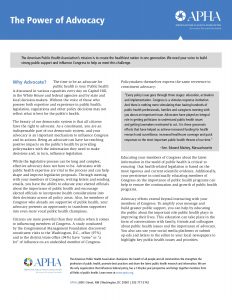An Introduction to Advocacy
What is advocacy?
Advocacy as a term is flexible and inclusive. It might better be defined by intent than actual delivery. Generally speaking, advocacy is the public support of a particular cause and/or policy or law; advocacy can be conducted by an individual or group. Group members may consist of a small number of close friends or the group can span many nations and members don’t actually personally know one another and only converse via social media–or maybe not at all.
Advocacy should be empowering
Advocacy can empower those who advocate as well as those who reap the benefits of advocacy efforts–all while engaging and applying pressure to deciding bodies (such as the EPA) and individuals possessing the power to change the status quo (such as Congress members).
The goal of advocacy is usually to impact the status quo to such a degree that a desired change is adopted, such a the passage of a bill (approving the bill to become law). However, advocacy is not limited to the creation of legislation. Advocacy may also include increasing the knowledge of an issue (such as climate change) or the social acceptance/inclusive/integration of an idea (public breastfeeding) .
TL;DR (Too Long, Didn’t Read): Advocacy seeks to engage, educate, and/or empower.
Check out this publication by the American Public Health Association (APHA).

Advocacy Resources
There are several amazing organizations that students can join to learn how to become an advocate and perform advocacy on an array of issues. Here are a few to check out:
- American Public Health Association, Student Assembly: The nation’s largest student-led dedication to the future generation of public health and health-related professionals: https://www.apha.org/APHA-Communities/Student-Assembly
- United States Student Association (USSA): The oldest and largest student association in the U.S.: https://www.apha.org/APHA-Communities/Student-Assembly

